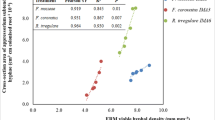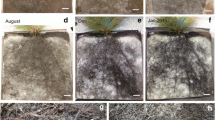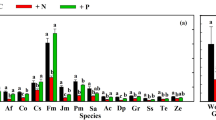Summary
Plants ofPicea abies (L.) Karst were grown in mycorrhizal association withTelephora terrestris (Pers. ex Fr.) andPisolithus tinctorius (Mich. ex Pers.) Coker and Couch on sphagnum peat in petri dishes or Perspex chambers. After 1 yearT. terrestris had formed prominent rhizomorphs which were characterized by light microscopy and investigated for32P-orthophosphate uptake. The absorbed phosphate was transported to sinks throughout the rhizomorphal system as well as into the plant. The calculated translocation velocity and flux rate in the rhizomorph were in the range of 1–3 cm/h and 0.5–4.0 × 10-10 mol cm-2 s-1, respectively. Label was observed to accumulate in the needles 2–3 days after application. Feeding a non-mycorrhized root with32P-orthophosphate led to an accumulation of label in needles within 1 h, but no radioactivity appeared in the associatedT. terrestris rhizomorphs. The rhizomorphs ofP. tinctorius revealed a higher structural differentiation than those ofT. terrestris. Translocation of labelled phosphorus through rhizomorphs ofP. tinctorius into spruce needles was also demonstrated.
Similar content being viewed by others
References
Agerer R (1987a) The ecological crucial question of ectomycorrhizae: how to make rhizomorphs. In: Sylvia DM, Hung LL, Graham JH (eds) Mycorrhizae in the next decade — practical applications and research priorities. Proc NACOM 7, Gainesville, Fla., p 184
Agerer R (1987b) Studies on ectomycorrhizae IX. Mycorrhizae formed byTricholoma sulphureum andT. vaccinium on spruce. Mycotaxon 28: 327–360
Agerer R (1988) Studies on ectomycorrhizae XVII. The ontogeny of the ectomycorrhizal rhizomorphs ofPaxillus involutus andTelephora terrestris (Basidiomycetes). Nova Hedwigia 2 Kryptogamenkd 47: 311–334
Agerer R, Weiß M (1989) Studies on ectomycorrhizae XX. Mycorrhizae formed byTelephora terrestris on Norway spruce. Mycologia (in press)
Agerer R, Brand F, Gronbach E (1986) Die exakte Kenntnis der Ektomykorrhizen als Voraussetzung für Feinwurzel untersuchungen im Zusammenhang mit dem Waldsterben. Allgem Forst-Z 20: 497–503
Brand F (1989) Studies on ectomycorrhizae. XXI. Beech ectomycorrhizae and rhizomorphs ofXerocomus chrysenteron (Boletales). Nova Hedwigia 2 Kryptogamenkd (in press)
Duddridge JA, Malibari A, Read DJ (1980) Structure and function of mycorrhizal rhizomorphs with special reference in their role in water transport. Nature 287: 834–836
Finlay RD, Read DJ (1986) The structure and function of vegetative mycelium of ectomycorrhizal plants. II. The uptake and distribution of phosphorus by mycelial strands interconnecting host plants. New Phytol 103: 157–165
Forschungsbeirat (1986) Waldschäden/Luftverunreinigungen. 2. Bericht der Bundesregierung. KfK, Karlsruhe
Gronbach E (1988) Charakterisierung und Identifizierung von Ektomykorrhizen in einem Fichtenbestand mit Untersuchungen zur Merkmalsvariabilität in sauer beregneten Flächen. Bibl Mycol 125: 1–216
Harley JL, Smith SE (1983) Mycorrhizal symbiosis. Academic Press, New York
Haug I, Oberwinkler F (1987) Some distictive types of spruce mycorrhizae. Trees 1: 172–188
Ingestad T (1959) Studies on the nutrition of forest tree seedlings. II. Mineral nutrition of spruce. Physiol Plant 12: 568–593
Kottke I, Oberwinkler F (1986) Mycorrhiza of forest tree seedlings. Trees 1: 1–24
Marx DH (1969) The influence of ectotrophic mycorrhizal fungi on the resistence of pine roots to pathogenic infections. I. Antagonism of mycorrhizal fungi to root pathogenic fungi and soil bacteria. Phytopathology 10: 429–454
Melin E, Nilsson H (1950) Transfer of radioactive phosphorus to pine seedlings by means of mycorrhizal hyphae. Physiol Plant 3: 88–92
Rhodes LH, Hirrel MC (1982) Radiotracer methods for my corrhizal research. In: Schenck NC (ed) Methods and principles of mycorrhizal research. The American Phytopathological Society, St. Paul Minnesota, pp 189–200
Skinner MF, Bowen GD (1974) The uptake and translocation of phosphate by mycelial strands of pine mycorrhizas. Soil Biol Chem 6: 53–56
Strullu DG (1985) Les mycorrhizes. Encyclopedia of plant anatomy. Borntraeger, Berlin
Weigl J, Ziegler H (1960) Wasserhaushalt und Stoffleitung beiMerulius lacrymans (Wulf.) Fr Arch Mikrobiol 37: 124–133
Author information
Authors and Affiliations
Rights and permissions
About this article
Cite this article
Kammerbauer, H., Agerer, R. & Sandermann, H. Studies on ectomycorrhiza. Trees 3, 78–84 (1989). https://doi.org/10.1007/BF01021070
Received:
Issue Date:
DOI: https://doi.org/10.1007/BF01021070




